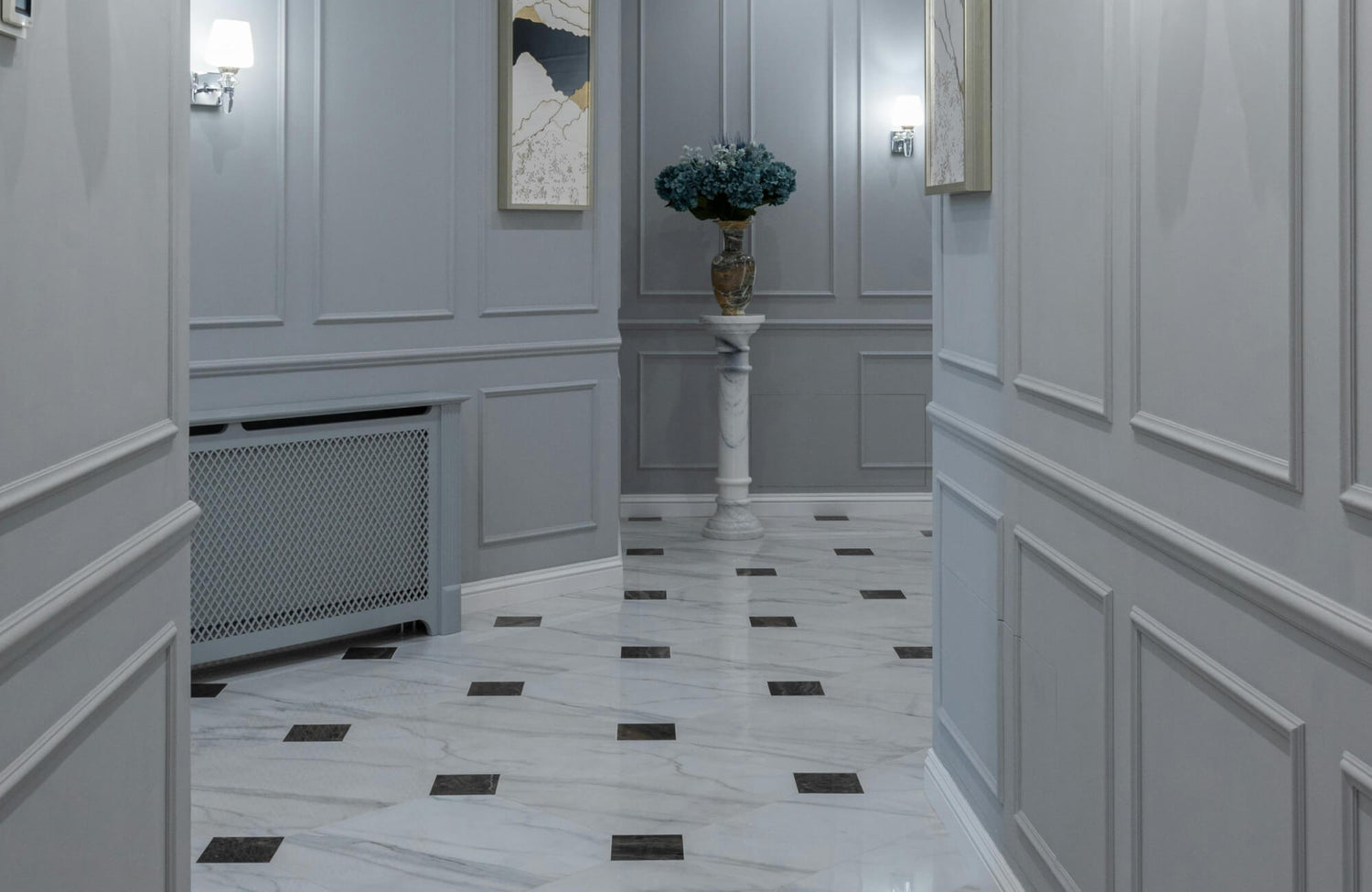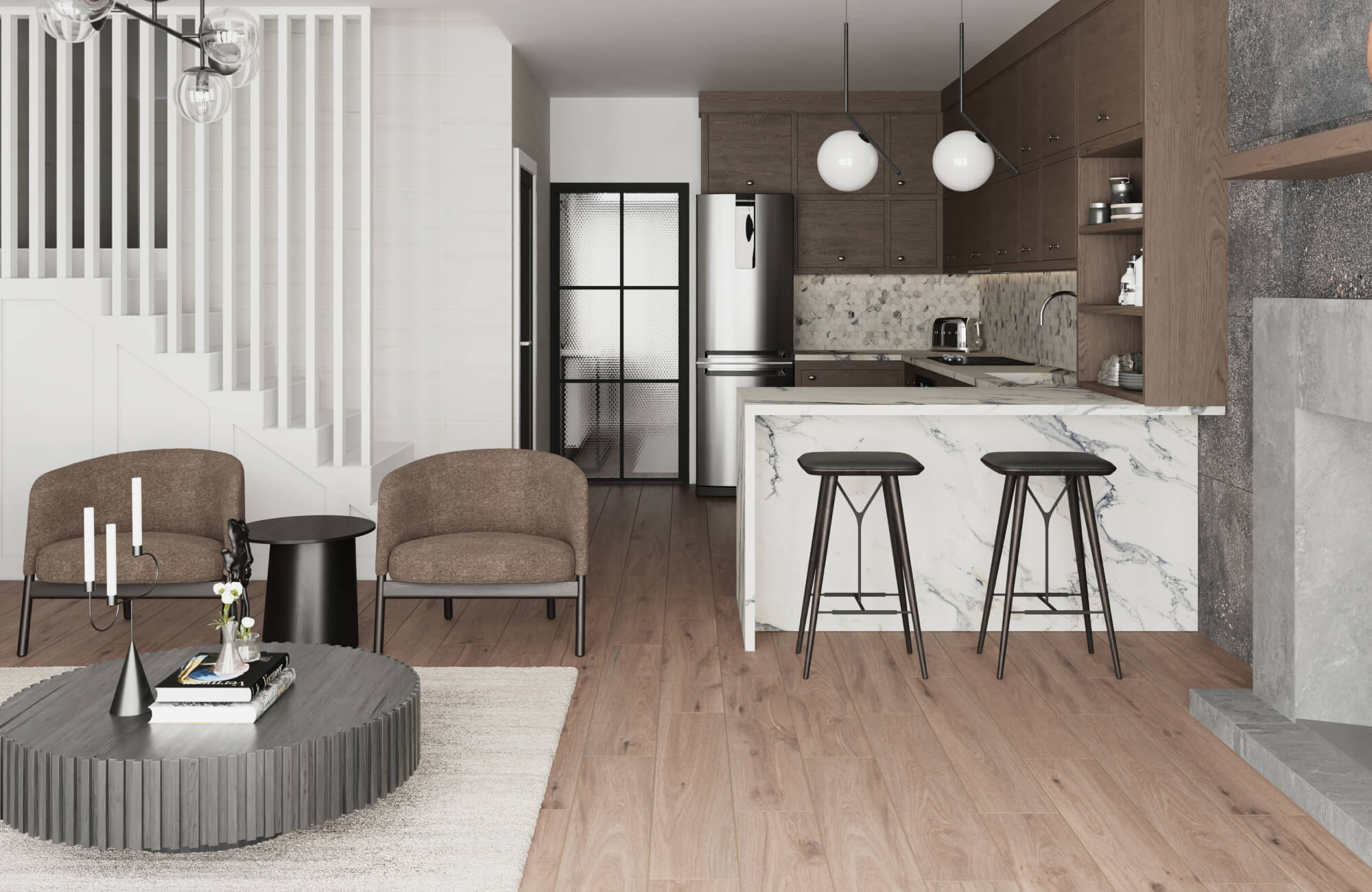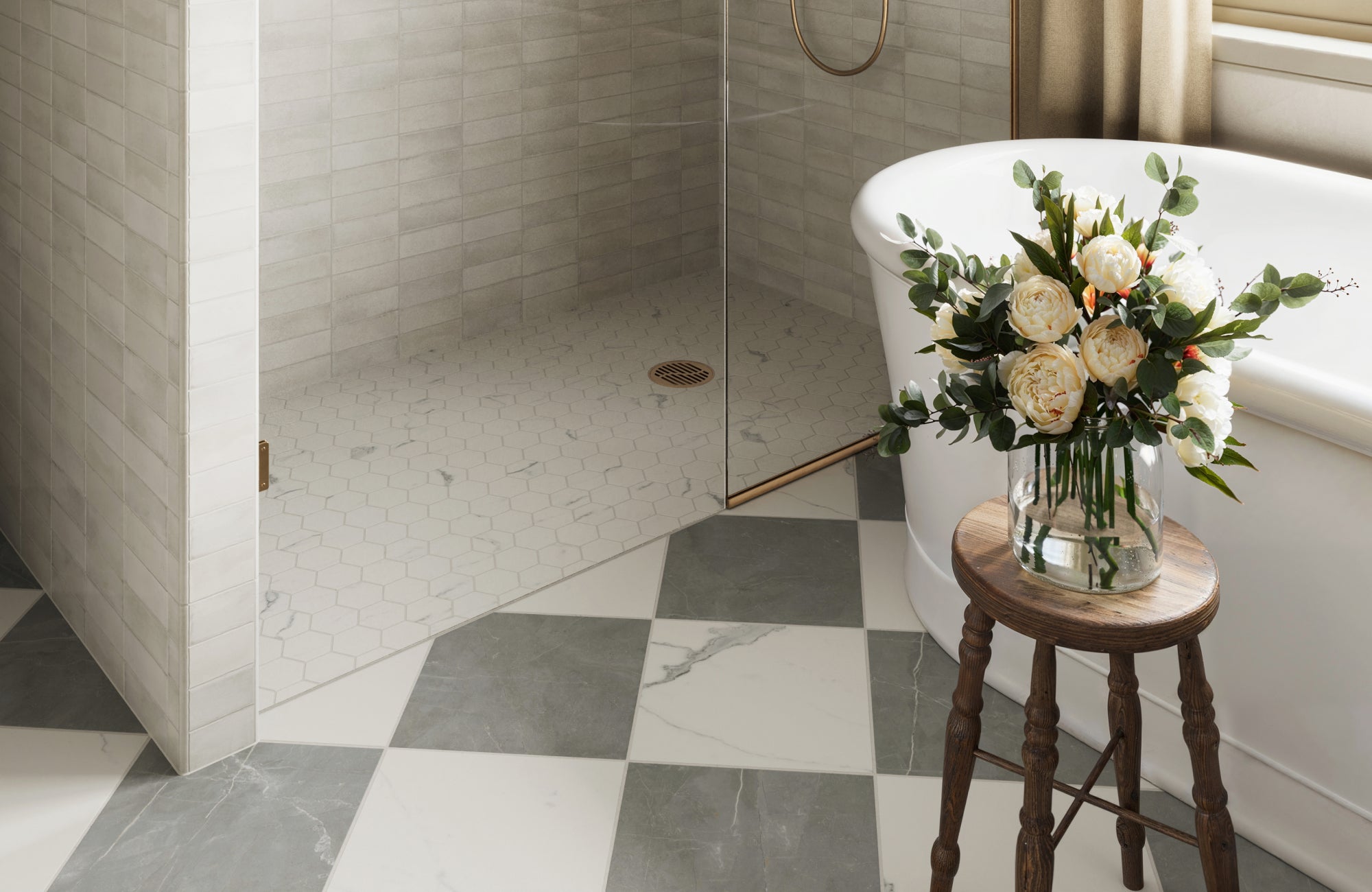Known for their timeless elegance and unmistakable luxury, marble tiles remain a popular choice for homeowners seeking to elevate the overall feel of their spaces. While their visual appeal is undeniable, they also raise important questions about cost, maintenance, and long-term practicality. If you're considering marble or marble look tiles, it's important to understand the full picture before making a decision.
In this article, we’ll cover everything from marble’s visual appeal and durability to its maintenance needs, installation considerations, alternatives, and environmental impact. Whether you’re renovating a kitchen, designing a bathroom, or planning a full home upgrade, these insights will help you decide whether marble tiles are the right fit for your style, budget, and daily lifestyle.

Beauty and Elegance of Marble Tiles
Marble tiles are famous for their exquisite veining, rich colors, and timeless appeal. From the classic white of Carrara to the golden warmth of Calacatta or the bold contrast of Nero Marquina, each type offers a distinct character that brings depth and elegance to any design. Beyond their visual beauty, these natural variations help shape the mood of a space, adding a refined and welcoming feel that few other materials can match.
Reflecting Light and Enhancing Ambiance
One of the most captivating qualities of marble is its ability to reflect light, enhancing the ambiance by creating an airy, expansive feel, while its veining adds depth and texture. This reflective quality not only brightens spaces but also complements marble's versatility in design applications, offering design possibilities that can transform any space into a work of art.
Marble's light-reflective properties are particularly effective in smaller or dimly lit areas, where they can make spaces appear larger and more inviting. In addition to that, the interplay of light with marble's natural patterns can bring out subtle color variations, enhancing the overall appearance of a room without overwhelming it with excessive decoration.
Versatility and Stunning Examples of Marble Tile Use
Marble tiles are remarkably versatile, offering a wide range of design possibilities that bring elegance and refinement to virtually any space. In kitchens, they elevate countertops and backsplashes with cohesive luxury, while marble flooring instantly enhances the room’s overall ambiance. Bathrooms can be transformed into spa-like retreats with marble walls, floors, and vanities. Even living rooms benefit from marble's timeless charm, especially when used around fireplace surrounds or as decorative accents.
To better illustrate this, imagine these real-world applications: In the kitchen, white Carrara marble countertops paired with a matching backsplash create a seamless, modern look. The soft veining introduces depth and texture, complementing clean cabinetry for a timeless finish. In bathrooms, Calacatta Gold marble on the walls and floors brings warmth and opulence, turning the space into a serene, spa-like retreat. Meanwhile, a Nero Marquina marble fireplace in the living room becomes a bold focal point. The rich black stone contrasts beautifully with lighter elements, adding a layer of sophistication and drama that anchors the entire room.
While we often celebrate marble for its striking appearance, the true measure of its value lies in its durability and the care it requires. We'll now take a closer look to determine if marble tile is truly worth it as a long-term investment in any property, considering these practical aspects.

Enduring Durability and Longevity
Marble tiles are valued not only for their beauty but also for their long-lasting durability. With proper care and quality installation, they can remain in excellent condition for decades. Key factors like material quality, maintenance, and handling all play a role in maximizing their lifespan.
The Importance of Quality
Although marble is naturally porous, tiles cut from high-quality stone blocks tend to have a more uniform structure and greater visual consistency, two qualities that significantly impact both longevity and appearance. Premium-grade marble often features more stable veining and a smoother finish, which can offer some resistance to surface damage. However, proper sealing and maintenance are still essential to protect against stains, etching, and wear.
Sourcing marble from reputable suppliers is just as important. It ensures you receive tiles with consistent coloration and refined veining, which are especially valuable for large-scale applications that require a cohesive look. Additionally, high-quality marble typically undergoes advanced finishing processes that not only enhance its appearance but also make routine cleaning more manageable, helping preserve its elegance for years to come.
Proper Installation Techniques
Proper installation is key to extending the life of your marble tiles. A skilled professional is essential for ensuring that tiles are installed securely and properly leveled, preventing common issues like cracks, water infiltration, and misalignment over time. Using the right adhesives and grout is equally important for a durable installation. Proper installation techniques also involve ensuring that the underlying surface is appropriately prepared, which includes being clean, level, and structurally sound to support the weight of the marble. Moreover, selecting the correct type of mortar and grout that matches the specific characteristics of marble is crucial to prevent staining and facilitate easier maintenance.
Sealing and Maintenance
Consistent sealing and maintenance are essential to keeping marble looking beautiful and ensuring its long-term durability. A high-quality sealant helps protect the surface by creating a barrier that prevents moisture and stains from seeping into the stone. To maintain that protection, it’s best to reseal the tiles periodically, ideally with guidance from a professional stone care specialist or experienced contractor.
For daily care, use pH-neutral cleaning products and avoid harsh chemicals that can damage the finish. Wipe up spills promptly to prevent staining, and regularly inspect the tiles for signs of wear. With the right upkeep, marble can retain its natural elegance for many years.
If the installation and maintenance requirements for marble tiles seem daunting, it may be worth considering alternative flooring options that offer similar ornamental value with less upkeep. These alternatives not only mimic the elegance of marble but also ensure greater practicality for daily use.

Exploring Sophisticated Options Beyond Marble Tiles
While marble tiles are renowned for their timeless beauty, there may be better choices for some designs due to their cost, maintenance requirements, and vulnerability to stains and scratches. Fortunately, several alternatives can offer a similar aesthetic while providing benefits such as lower costs and easier upkeep, making them a practical choice for balancing style and functionality.
Porcelain and Ceramic Marble Look Tiles
Porcelain marble look tiles are a top alternative to natural marble due to their impressive durability and versatility. They can be manufactured to closely mimic the appearance of marble, making them an excellent choice for those seeking a similar look at a lower cost. Highly resistant to stains, scratches, and water, porcelain marble look tiles are ideal for busy areas such as kitchens and bathrooms. For example, our Aniston 24x48 Matte Porcelain Tile in Calacatta Viola above captures the rich, bold character of natural stone while offering superior durability and easier maintenance. With a dense, non-porous structure, porcelain tiles are less likely to chip or crack and are available in a wide range of colors, finishes, and formats to suit various interior styles.
Ceramic marble look tiles, while generally more affordable than marble or porcelain, offer a range of styles and finishes that can similarly emulate marble. Although not exactly matching the luxury of marble or the resilience of porcelain, ceramic marble look tiles remain a stylish and functional choice. A great example is Edward Martin’s Julianna 4x12 Glossy Ceramic Tile in Carrara, which delivers a soft, classic marble look ideal for backsplashes or feature walls. Typically easier to maintain and less prone to damage than marble tiles, these tiles are well-suited for many residential applications and feature a broad selection of designs and colors. They are also easier to cut and install, potentially reducing installation costs.
Edward Martin's porcelain and ceramic marble look tiles, in particular, are crafted to be non-porous, eliminating the need for sealing. This feature simplifies maintenance and enhances their durability, making them ideal for use in even the most demanding environments. To help visualize how these tiles will look in your own space, Edward Martin offers an innovative AR tool, allowing you to preview different tile options virtually within your home, ensuring the perfect match for your design needs before making a decision.
Natural Stone Options
Natural stone alternatives, such as travertine and limestone, offer their own unique aesthetic qualities and can provide a warm, earthy feel similar to marble. Travertine features a distinctive texture and a range of natural colors, creating a rustic yet refined look. Limestone, with its soft hues and subtle patterns, offers a more understated elegance. However, these stones typically require more maintenance compared to marble. They are more porous and can be more susceptible to staining and scratching. Additionally, while they provide a natural and elegant appearance, their longevity and durability may not match those of porcelain tiles. Regular sealing and careful maintenance are necessary to keep these stones in good condition.
By exploring these alternatives, you can find a solution that aligns with your aesthetic goals and practical needs, ensuring you achieve the perfect look for your space while managing costs and maintenance effectively. This process also encourages a deeper consideration of how these choices impact the environment, aligning your home improvements with sustainable practices.
Sustainability and Environmental Impact of Marble Tiles and Alternatives
As sustainability becomes a growing concern for many homeowners, it’s important to evaluate the environmental impact of marble tiles compared to alternatives like porcelain and ceramic. Understanding the environmental impact of marble tiles and their alternatives is crucial when balancing design aspirations with eco-conscious values.
Marble, as a natural stone, requires a resource-heavy extraction process involving significant energy for quarrying, cutting, and transportation. This process contributes to carbon emissions and habitat disruption, particularly when marble is sourced from distant regions. While marble is a long-lasting material that can potentially be reused or recycled, the environmental footprint during its production and transport is something eco-conscious homeowners should consider.
In contrast, porcelain and ceramic marble look tiles are typically more sustainable and energy-efficient to produce. Both materials can be manufactured using more controlled, energy-efficient processes, and many manufacturers incorporate recycled materials into their production, further reducing waste. Porcelain marble look tiles, known for their durability, can have a longer lifespan with less environmental impact, especially if locally produced. Ceramic marble look tiles, while not as dense as porcelain, also have a lower environmental footprint compared to natural stone, as they don’t require the same level of extraction and transportation.
Evaluating the Value of Marble Tiles for Your Space
Marble tiles offer unparalleled luxury and elegance, making them an attractive option for many. However, their high upfront cost and ongoing maintenance may not be suitable for every project. When evaluating whether marble tiles are right for your space, it's essential to weigh their undeniable aesthetic appeal against practical factors like durability, upkeep, cost, and environmental impact. Marble's natural beauty and ability to elevate a space's ambiance make it a strong contender for those seeking sophistication, but it's crucial to consider how it fits within your lifestyle and budget.
Alternatives like porcelain and ceramic marble look tiles offer similar aesthetics with less maintenance and lower costs. These alternatives also offer significant sustainability benefits, which may align better with eco-conscious values. To ensure you select the perfect marble look tiles for your space, Edward Martin offers high-quality 4" x 4" samples that accurately reflect the color and finish of all tile sizes within each collection, allowing you to receive a true representation of our premium products before making your final decision. By carefully considering your design goals and practical needs, you can confidently decide which tile is the best fit for your home.









